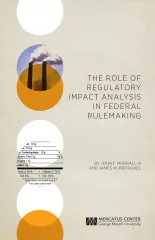- | Regulation Regulation
- | Working Papers Working Papers
- |
Improvements in SEC Economic Analysis since Business Roundtable
In a relatively short period of time, the SEC issued new guidance for economic analysis, reorganized internally to give economists a greater voice in rulemaking, and produced a measurable improvement in the quality of the economic analysis accompanying its regulations.
There has been much debate in recent years over the proper role of the judiciary in reviewing regulatory agencies’ economic analysis of proposed major regulations. Several recent court cases suggest the courts will be more willing to review the quality and use of economic analysis by regulatory agencies in the future. Three cases in particular have provided a natural experiment that reveals the effects of judicial oversight on regulatory analysis.
In this paper, Mercatus Senior Research Fellow Jerry Ellig looks at the effects of judicial oversight on the Securities and Exchange Commission (SEC) following a series of high-profile cases resting on the quality of the commission’s regulatory analysis. The study finds that the quality of SEC regulatory analysis has improved significantly, as have the commission’s explanations of how that analysis informed its decisions. While SEC regulatory analysis still has room to improve, these results suggest that judicial oversight can play a powerful role in encouraging agencies to base their regulations on economic reality rather than speculation.
BACKGROUND
A thorough regulatory impact analysis (RIA) identifies the cause of the problem the regulatory agency seeks to solve, develops alternative solutions, and assesses the potential benefits and costs of the alternatives.
- Executive orders require executive branch agencies to conduct regulatory impact analysis when they develop significant new regulations. The Office of Information and Regulatory Affairs reviews new regulations and the accompanying analyses before the regulations can be proposed or finalized. Independent agencies, on the other hand, are often not required to conduct regulatory impact analysis, and even if they are, the only potential scrutiny they face is from judges, who are often highly deferential.
- The SEC recently lost a series of court cases in which the judges were less deferential, subjecting the commission’s reasoning to greater scrutiny.
- These recent decisions led to the SEC issuing new guidance for economic analysis that emphasized executive branch standards and the more prominent involvement of economists in rulemaking.
- These legal defeats came largely as a surprise to the SEC, making its response an excellent natural experiment for investigating the efficacy of judicial review.
METHOD OF ANALYSIS
The study compares the two most recent (as of January 2016) final, nontemporary rules from each of the SEC’s three primary rulemaking divisions, plus a seventh rule from two divisions, to a set of rules examined in a preguidance study using nearly identical methodology. Both sets of rules are analyzed and scored using the Mercatus Center’s Regulatory Report Card evaluation method, which uses four criteria provided as guidance to executive agencies (analysis of the underlying systemic problem, alternatives, benefits, and costs), plus two criteria that assess how well the agency explained its use of the analysis. Scores range from zero (no useful content) to five (comprehensive analysis with potential best practices).
RESULTS
Simple averages and more rigorous econometric analyses both show a large improvement in SEC postguidance analysis:
- Significant improvement in RIA following guidance. The SEC’s average score almost doubled after its guidance was issued, and this difference is highly statistically significant.
- Parity with executive agencies’ analysis of financial regulations. The difference between the SEC’s average postguidance score and the average scores for financial regulations issued by executive branch agencies is not statistically significant. Thus, the quality of the SEC’s economic analysis is about the same as that of financial regulators in the executive branch.
- Significant improvements in explanation of use. The SEC greatly improved its explanations of how various aspects of its economic analysis informed its decisions; its average score for “Any use of analysis” nearly doubled.
- Improvements in both qualitative and quantitative analysis. Improvement occurred on “conceptual” criteria that do not require quantification as well as on criteria that require quantification.
- Improvement is significant after controlling for other factors. Multiple econometric models find that postguidance SEC regulations are accompanied by significantly better economic analysis than preguidance regulations. These models control for the complexity and political salience of the regulation, the size of the regulation’s economic effects, and agency-specific factors.
- Analysis of financial regulations is not more difficult than analysis of other types of regulations. After controlling for other factors, financial regulations have slightly higher-quality analysis than nonfinancial regulations, undercutting the claim that economic analysis is unusually difficult for financial regulations.
CONCLUSION
The SEC example illustrates how judicial review can prompt a regulatory agency to produce higher-quality analysis and provide a more complete explanation of how that analysis affected its decisions. While the SEC (like many federal agencies) still has significant room to improve its regulatory analysis, the results discussed here are encouraging. In a relatively short period of time, the SEC issued new guidance for economic analysis, reorganized internally to give economists a greater voice in rulemaking, and produced a measurable improvement in the quality of the economic analysis accompanying its regulations.


